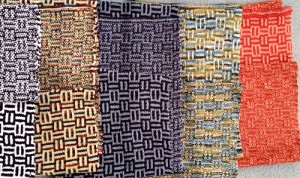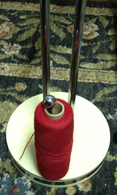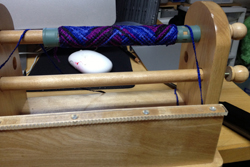I have been working on a series of tuck reversible chenille scarves. Color changing occurs every 2 rows. I do use 2 carriages. IMO the brother 2 color single bed changer was one of the worst designed accessories ever. The chenille is cranky, knitting is slow, and one is looking at the back of the knit so the pattern is not immediately obvious to the eye. These are a few colorways
thinking I had the knitting down, got to # 12 scarf, realized I needed to knit 10 more rows after canceling needle selection, “corrected” for row count, finished knitting the pattern, completed the edging, and realized the “corrected” rows were off and that this whole scarf has a mystery repeat. Here is an image of the front of the piece after unraveling edging and back to a row ready for rehanging next to a previously knit “how it should look”
it is an interesting variation of the pattern repeat, but without fiddling with starting rows, I have no clear idea how to duplicate it should I want to. Knitting rooms seem to have days when they are full of goblins.
I have some issues with my back and right arm was looking for an easier way to manage the knitting of these things and the reach required to get the carriages off the beds while knitting with the opposing one and had forgotten about this particular “stand”. A few years ago I broke my right shoulder, and as I began to regain use of the arm I went looking for an adjustable height, stable KM “stand”. A friend found this for me. It is what I can only be described as an ancient, asylum quality hospital bedside stand. It is probably at least part iron since magnets stick to its metal parts, are very heavy, has a huge adjustable height range, and does not budge during knitting in spite of the fact it is on wheels, while it is easily moved when one wants to do so. It was “free” as well, an added bonus.
When knitting fabrics single bed I do not work with the ribber engaged, have no idea if the added weight would be an issue or if the clearance is adequate for attaching it to the “stand”, but using the ribber clamps with the main bed at an angle seems to make crankier fabrics easier to knit. The crank for raising/lowering the height easily stores lace extension rails.
A kitchen timer is handy to get an accurate gauge as to how long the items actually take to knit from beginning to completion in helping set retail prices for new items, and kitchen scales to weigh cones before and after (grams or ounces) aid not just to gauge the cost of materials, but also to be certain that yarn quantity is adequate to finish the piece.
In static season some of the problems with yarn management or electronic KM pattern shifts can be resolved by both having a grounding wire, and using a humidifier. One such model may be seen in the lower left of the photo, is very inexpensive, designed for use in nurseries, on the noisy side, but requires no special care other than occasionally cleaning out the water container, and uses tap water.
Canned air can help remove fiber dust during knitting so it does not become part of the finished piece when using a brush or small vacuum is impractical, it is best not to use it in places where the fuzz is likely to get blown into springs and electronic parts, however.
Paper towel holders can serve as yarn cone holders for ones that tip over easily, and the extra straight arm they sometimes have in models similar to the one below can help hold upright yarn wounds on tubes of various sizes, an alternative to the usual horizontal ways of managing such.
Craft ribbon holders can serve the same purpose if one wants to feed tubes horizontally in addition to the old super low tech tricks of HK needles poked through a variety of holders with caps to help secure them in place
.





